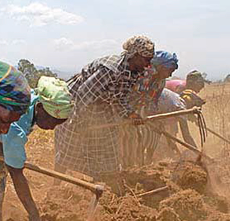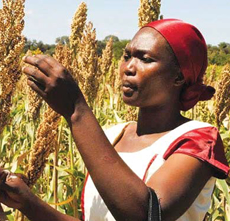Galana/Kulalu Ready for Large- Scale Commercial Production
 Water and Irrigation Cabinet Secretary Sicily Kariuki has said the government has started the process of commercializing the 10,000-acre model farm at the Galana/Kulalu Food Security Project in Kilifi and Tana River Counties.
Water and Irrigation Cabinet Secretary Sicily Kariuki has said the government has started the process of commercializing the 10,000-acre model farm at the Galana/Kulalu Food Security Project in Kilifi and Tana River Counties.
Ms Kariuki said her Ministry and that of the National Treasury were in the process of identifying a local or international private sector actor to carry on with the work once the National Irrigation Authority (NIA) finalizes the setting up of basic irrigation infrastructure on the model farm.
The CS said that her ministry, through the NIA, was in the final stages of the setting up of the basic irrigation infrastructure on the remaining 4,900 acres of the model farm before the project is left in the hands of the private sector.
“The process is being managed by the National Treasury right now. Already investor briefings have been done. The project is packaged and is already out in the market under the National Treasury, which is the lead agency in all Public Private Partnership (PPP) programmes,” CS Kariuki said.
 There has been a debate on the role of youth in agriculture and how to involve them in agriculture. However, inadequate focus has been channeled towards why majority of the youths have not adopted agriculture despite them being unemployed. This article will critically assess the current situation of agriculture in Kenya, the reasons why there is low adoption of agriculture as an occupation and career by youths and strategies that can increase engagement of youth in agriculture.
There has been a debate on the role of youth in agriculture and how to involve them in agriculture. However, inadequate focus has been channeled towards why majority of the youths have not adopted agriculture despite them being unemployed. This article will critically assess the current situation of agriculture in Kenya, the reasons why there is low adoption of agriculture as an occupation and career by youths and strategies that can increase engagement of youth in agriculture. The word gender describes a social construct that ascribes roles, rules (norms), responsibilities, opportunities, power, behaviour and what the society considers appropriate for men and women. Though fluid and context-specific, the construction of gender underlines the reason for the persistence of gender inequality experienced differently by men and women. Gender construction is as old as the human race, and so is gender inequality. We are all influenced by gender.
The word gender describes a social construct that ascribes roles, rules (norms), responsibilities, opportunities, power, behaviour and what the society considers appropriate for men and women. Though fluid and context-specific, the construction of gender underlines the reason for the persistence of gender inequality experienced differently by men and women. Gender construction is as old as the human race, and so is gender inequality. We are all influenced by gender. Since the 1980s, the International Maize and Wheat Improvement Center (CIMMYT) and the International Institute of Tropical Agriculture (IITA) have spearheaded the development and deployment of climate-smart maize in Africa.
Since the 1980s, the International Maize and Wheat Improvement Center (CIMMYT) and the International Institute of Tropical Agriculture (IITA) have spearheaded the development and deployment of climate-smart maize in Africa. What Is IPM: A Concise Abbreviation for A Comprehensive Approach
What Is IPM: A Concise Abbreviation for A Comprehensive Approach